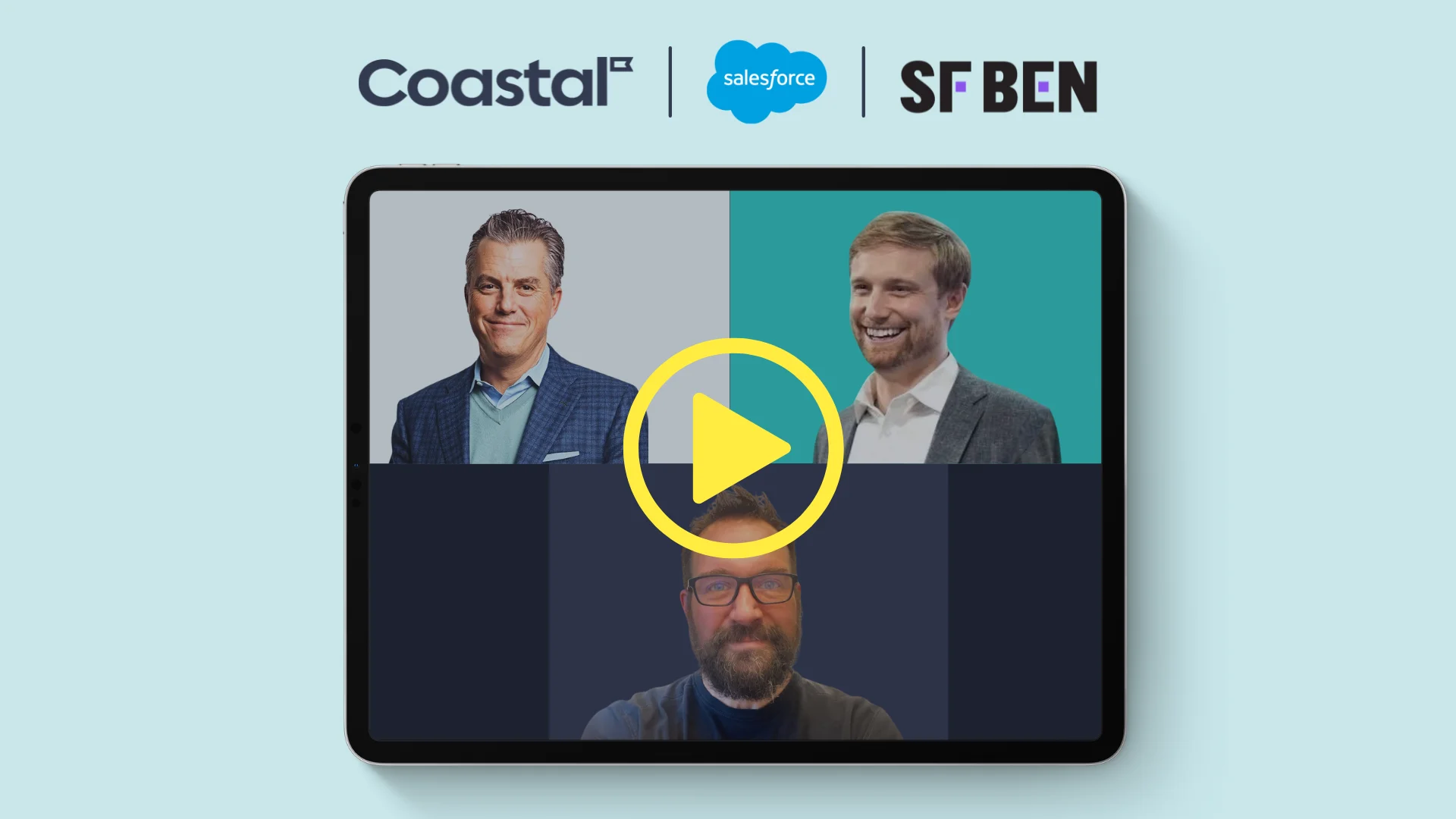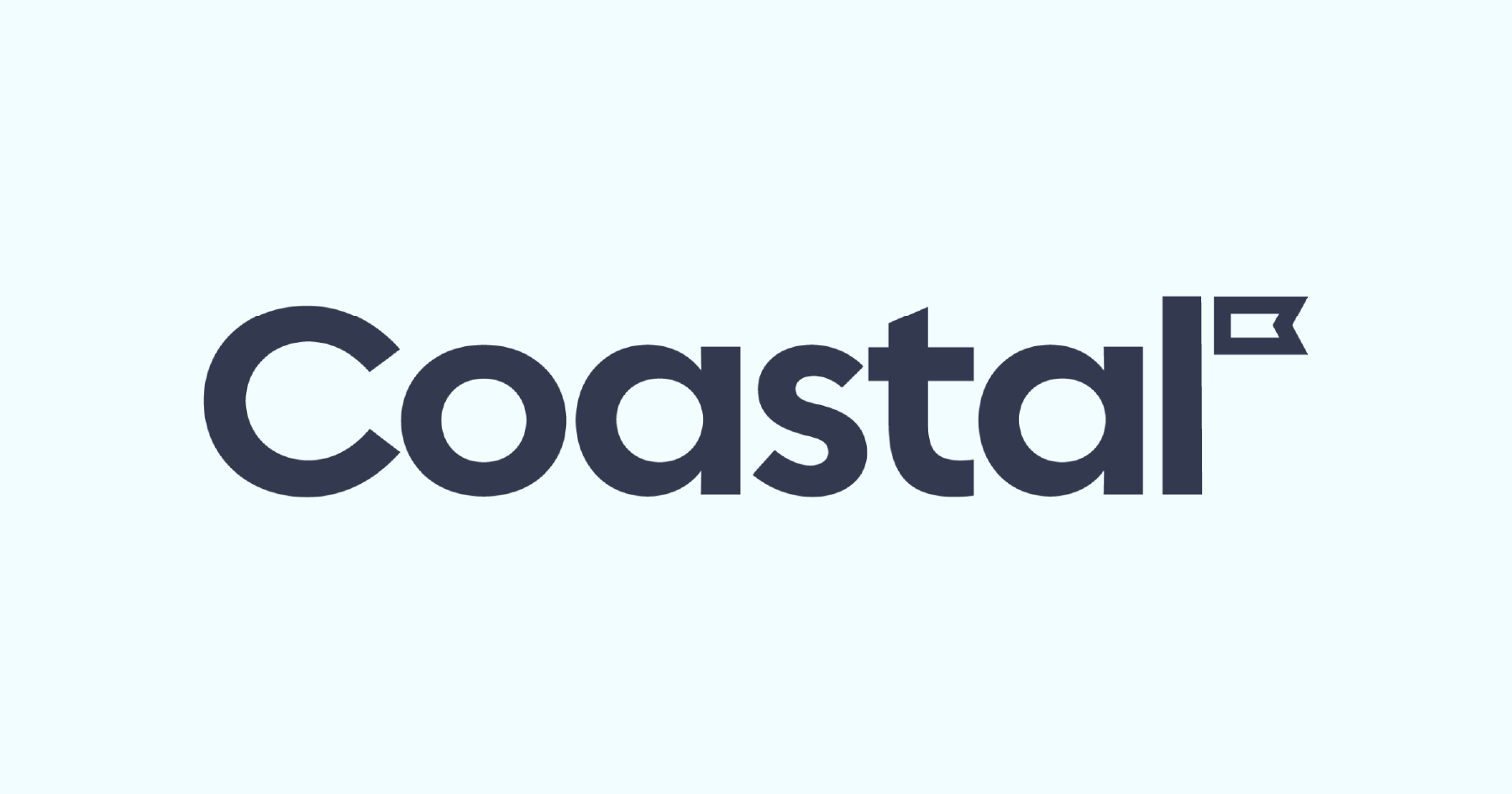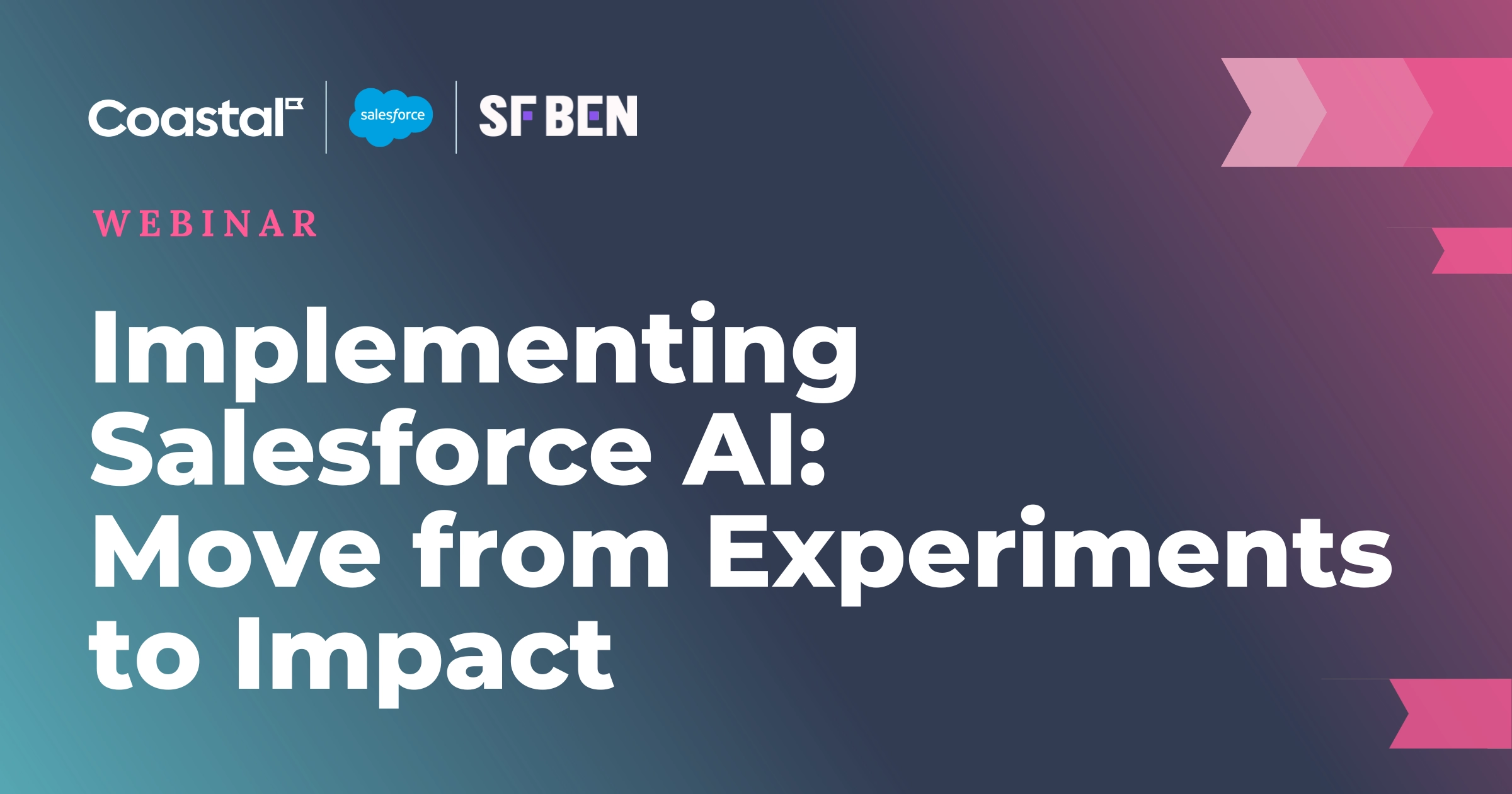Hosted by Salesforce Ben, this webinar brought together leaders from Coastal, Salesforce, and Mural to unpack why AI isn’t delivering—and what to do about it.
The AI Stall-Out: It’s Not the Tech That’s Broken
AI investment is growing. But the results? Still limited.
Two-thirds of Salesforce-powered organizations are increasing their AI budgets. Yet only 21% say they’re seeing proven outcomes.
That gap was the focus of our recent webinar with Eric Berridge (Coastal), Max Kirby (Salesforce), and Paul Wilson (Mural). Together, they unpacked what’s getting in the way—and how to move forward with clarity and purpose.
Meet the Panel
Eric Berridge is the CEO of Coastal and a longtime leader in the Salesforce ecosystem. He co-founded Bluewolf back in 2000—the original Salesforce consultancy, later acquired by IBM—and brings 25 years of experience helping companies navigate big tech shifts with systems and strategies that deliver results.
Max Kirby is Principal AI Architect at Salesforce, specializing in agentic AI and semantic data. With 15 years of experience in emerging technology, he’s an award-winning speaker who explores the intersection of technology, policy, and philosophy.
Paul Wilson leads Mural’s Go-to-Market Systems, modernizing data infrastructure to fuel product-led growth. With 15+ years in CRM and martech at Salesforce, Adobe, and Slack, he’s now building a composable, AI-ready architecture to deliver connected experiences across sales, support, and product.
What to Watch: Key Moments from the Webinar
Didn’t catch the full session? These highlights cut straight to the real blockers—and breakthroughs—in getting AI to deliver results.
[06:47] The Disconnect
What do cloud adoption and AI have in common? Eric draws the parallel—and reveals why many teams are stalling for the same reasons now as they did then. A must-watch if you’re wondering why more investment isn’t translating to more impact.
[10:06] What’s Actually Blocking AI Performance
It’s not the models. It’s the mindset. Max unpacks the three hidden forces that keep AI stuck in pilot mode—and what needs to shift to move forward. These are the blockers that most roadmaps miss.
[13:09] Making Sense of the Semantic Layer
If your AI doesn’t understand your business, it won’t help you run it. Max explains the semantic layer in plain terms—and why it’s critical to getting AI right.
[23:29] AI That Reduces Friction, Not Adds to It
Imagine never typing another CRM update. Max shares how voice-driven data entry isn’t just cool—it’s one of the most practical, pain-relieving AI use cases out there. And it’s already working.
[27:31] Workflows That Weren’t Built for Agents
Paul pulls back the curtain on why so many processes—even the “automated” ones—still rely on human glue. This section is for anyone asking, “Why isn’t this scaling?”
[35:08] Measuring the Right Outcomes
Spoiler: it’s not about agent utilization. It’s about value created. The panel offers a smarter way to define success—and shares the metrics that actually reflect whether AI is working.
[40:52] Reclaiming Time for What Matters
Eric brings it home with a reminder that’s easy to forget in the AI rush: this isn’t about replacing people. It’s about making space for them to do the things only people can do.
5 Takeaways That Cut Through the Noise
1. Architecture First. Then Use Cases.
AI bolted onto legacy systems won’t scale. Modern AI requires architecture that connects core systems, moves data across platforms, and activates it in real time. That may mean Salesforce handles orchestration, not storage.
2. Build a Business-Aware Semantic Layer
It’s the shared language your agents need to understand your data. The semantic layer maps business terms to meaning—and gives your AI the context to act with confidence. Max’s advice: start with one use case, and work backward from the outcome.
3. Natural Language Input Changes the Game
After a customer meeting, reps can dictate what happened, and let the system translate it into structured data. It’s faster, more accurate, and better reflects how people actually work. That kind of input unlocks richer insights across the platform.
4. Processes Need Redesign, Not Just Automation
Most legacy workflows weren’t built for agents. They assume human decision-making, rely on unspoken rules, and slow down in the face of edge cases. AI-ready processes are simplified, standardized, and designed for speed and autonomy.
5. Treat AI as an Organizational Learning Opportunity
AI isn’t just a productivity tool—it’s a catalyst for change. As Max noted, successful organizations are becoming learning organizations: focused on understanding what they need to know, and building the capacity to act on it.
A Smarter Framework for Action
Start with Business Outcomes
What are you trying to improve? Look for high-volume, high-cost processes that eat up time and don’t scale well. Define success in business terms—efficiency, margin, satisfaction—not just technical completion.
Modernize Selectively
Take Mural’s approach: they use Salesforce and Data Cloud for business processes, an enterprise data platform as their data lakehouse, and zero-copy architecture to unify access. No data duplication. No transformation delays. Just insights where they’re needed. Paul’s team can now surface product usage signals directly on account records—eliminating the need for sales reps to dig through separate analytics tools.
Choose Use Cases That Unlock More
Pick use cases that create downstream value: better data, better decisions, better outcomes. Natural language data entry is one example—it improves CRM quality, which improves targeting, which improves engagement.
Separate Learning from Optimization
Max recommends separating the “build to learn” phase from the “build to scale” phase. Use a fixed budget to explore, then shift to performance-based metrics when you’re confident in the value.
Redesign Workflows for Agentic AI
Remove unnecessary approvals and manual handoffs. Document how your processes work today—and then rebuild them for consistency and autonomy. Start with routines where agents can deliver end-to-end value.
The Big Picture: Execution Is the Differentiator
The next wave of AI success won’t go to early adopters. It’ll go to those who execute well.
That means:
- Reworking architecture so data flows, not just sits in reports
- Reshaping workflows so agents can act, not get stuck
- Realigning teams around measurable outcomes that matter
As Paul put it, “Every ICP moment becomes an adaptation. The message might be ‘We’re not a good fit’—and that’s a better experience than the wrong one.”
Ready to Get More from AI? Here’s Where to Start
AI doesn’t create value on its own. The teams getting results are the ones with strong foundations: modern architecture, streamlined processes, and a clear focus on outcomes.
Read the Report
AI Isn’t Delivering—Here’s What To Do About It
Explore what’s getting in the way and how to build for scale.
Watch the Full Webinar
Hear directly from Coastal, Salesforce, and Mural on what it takes to move from AI ambition to action.






